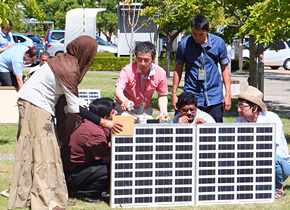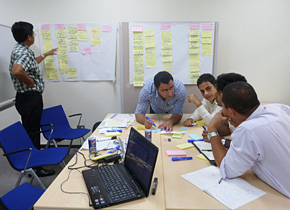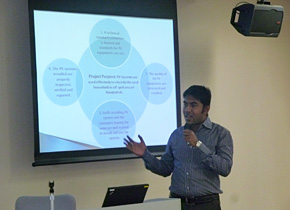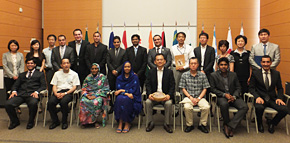Looking ahead to the dissemination of solar power generation technologies Training For Planners to the Promotion of Photovoltaic Power Generation
Solar power generation systems, whose introduction has advanced in Japan in the last several years, are attracting attention overseas as well, as a means of diversifying energy resources, tackling climate change, supplying power in times of insufficiency and electrification of regional areas. PREX has been implementing JICA seminars related to solar power generation for four years since fiscal 2009, covering 105 participants from 38 countries. Demand for the seminars’ implementation remains strong in various countries. For a three-year period starting this fiscal year, we have been commissioned to hold the “Training For Planners to the Promotion of Photovoltaic Power Generation” twice a year.

Practical training takes place under the blazing sun. The seminar participants measure voltage and current while under the guidance of Japanese and third-country specialists.
Classroom and practical lessons to acquire basic knowledge
In this seminar, the course advisers and lecturers were experts familiar with the solar-power generation field in developing countries. They kindly provided a set of lectures on introduction planning, government policy and systems, and another set on design, construction and maintenance and management technologies. Although most of the seminar participants are public-sector officials tasked with spreading the use of solar power generation in their respective countries, they also each have varying standpoints and represent a variety of backgrounds, as some are technical officials, policymakers and so on. The seminar was devised to promote an appreciation of introduction planning, policy and systems among the technical officials, while having the policymakers acquire learning of basic technologies, so that the seminar could meet the needs and requests of each of the participants as much as possible.
The lectures related to introduction planning, government policy and systems involved accounting exercises in cost-benefit analyses and feasibility evaluations, using Excel spreadsheets. The idea was to deepen an understanding of Japan’s policies on renewable energies and of the background and actual situation of its systems. The lectures related to technology were to create an understanding of how solar radiation volumes and temperature, angle of panel installation and other factors can convert output, and also how electric voltage and current change when panels are connected in series or parallel. Practical training was conducted using panels, batteries, measuring instruments and other equipment. A review session was held at the end of the lectures. The participants revealed the issues in their own countries and clarified the issues that needed to be tackled.
Visit to companies associated with solar power generation
A large number of companies associated with environmental and energy industries, including solar power generation, are concentrated in the Kansai region. In this seminar, the participants were able to visit a large number of companies that manufacture solar panels, power conditioners and batteries, and contractors, including an electric power company. At the electric power company, they heard a summary about Japan’s power supply and demand and details of the issues that occur when solar power generation is introduced. The participants asked the companies lots of questions about the technical issues to be confronted when connecting solar power to the grid, responses in times of accidents and the spread of renewable energies, including solar power. At a company that manufactures devices for solar-power generation, the participants were allowed to inspect a production line, and they listened to enthusiastic explanations on the products’ features and nature. It felt like they were surprised at the extensiveness of quality control and after-service at Japanese companies. The production lines for solar power-related devices seemed to become busier since the introduction of a FIT:Feed In Tariff system for renewable energies. When the participants saw the workers wrapped up in their jobs, many acutely sensed the passion and seriousness that Japanese people have toward their work. We expect that human networks between the companies and the participants will be built through the corporate visits, becoming a bridge to future business in the solar power generation industry.
- The participants discuss the technical issues involved in spreading solar power generation in their own countries, at a midpoint review session.
- Participants making a presentation on their action plans (PDM) for after returning home, at the last session of the training course.
- Commemorative photos are taken at JICA Kansai at the closing ceremony. (The writer, Yoko Sakaguchi, is in the back far left)
Toward measures after returning home
A presentation session was set up in the seminar’s final stage. The participants compiled their plans for projects to be implemented after their return to their home countries, using a Project Design Matrix (PDM, a single sheet of a project’s outline).
They cited titles for their projects, mentioning their own countries’ priority issues, including:
・The spread of solar power generation in regions not yet electrified
・The effective use and promotion of power-grid connection and independent systems
・Development of tariff policies for mega-solar power generation
(Sakaguchi, PREX)





